Japan Socialist Party
Japan Socialist Party 日本社会党 Nippon shakai-tō or Nihon shakai-tō | |
|---|---|
 | |
| Founded | 2 November 1945[1][2] |
| Dissolved | 19 January 1996[1][2] |
| Succeeded by | Social Democratic Party[1][2] |
| Headquarters | Social & Cultural Center 1-8-1 Nagata-cho, Chiyoda-ku, Tokyo |
| Newspaper | [3] |
| Ideology | |
| Political position | Centre-left[1] to left-wing[4] |
| International affiliation | Socialist International[5] |
| Colors | Blue |
The Japan Socialist Party (日本社会党, Nihon Shakai Tō), also known as the JSP, was a socialist political party in Japan that existed from 1945 to 1996. The party was founded by members of several former proletarian parties that existed before World War II, including the Social Mass Party, the Labour-Farmer Party, and the Japan Labour-Farmer Party.
The JSP was briefly in power from 1947 to 1948. From 1951 to 1955, the JSP was divided into the Left Socialist Party and the Right Socialist Party. In the same year, the two major conservative parties in Japan merged to form the Liberal Democratic Party (LDP), which established the 1955 System, and allowing the LDP to continuously hold power. The JSP was the largest opposition party but was incapable of forming a government. Nonetheless, the JSP managed to hold about one third of the seats in the National Diet during this period, preventing the LDP from revising the Constitution of Japan.[1][2][6]
In the late 1980s and early 1990s, the JSP under the leadership of Takako Doi earned a record-high number of seats. Shocked by the establishment of new conservative parties, the party's seats in the National Diet decreased significantly in the mid-1990s, and the JSP was dissolved in 1996. Its successor is the Social Democratic Party, a minor party only holding four representatives in the National Diet as of 2020. There have been two JSP Prime Ministers of Japan, Tetsu Katayama and Tomiichi Murayama.
History[]
1940s[]
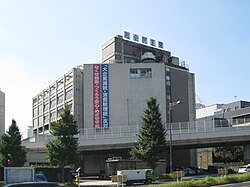
Socialist and social-democratic parties have been active in Japan under various names since the early 20th century, often suffering harsh government repression as well as ideological dissensions and splits. The party was originally known as the Social Democratic Party of Japan (SDPJ) in English and was formed in 1945 following the fall of the militarist regime that had led Japan into World War II. At the time, there was serious conflict inside the party between factions of the right and the left and the party's official name in English became the Japanese Socialist Party (JSP) as the left-wing had advocated. The right had wanted to use the older SDPJ.[citation needed]
The party became the largest political party in the first general election under the Constitution of Japan in 1947 (143 of 466 seats) and a government was formed by Tetsu Katayama, forming a coalition with the Democratic Party and the Citizens' Cooperation Party. Katayama's coalition fell in February 1948, in large part due to inexperience and subsequent poor performance in leading government.[7] Hitoshi Ashida succeeded Katayama as prime minister of a new coalition with the Democrats. In October 1948, just seven months after taking office, Ashida resigned due to his alleged involvement in the Showa Denko corruption scandal. In 1958, he was acquitted of all charges.[8] The confusion and disarray caused by the corruption scandal were part of what allowed Shigeru Yoshida and the Liberal Party to return to government.[citation needed]
In the period following the end of World War II, the JSP played a key role in the drafting of the new Japanese constitution, adding progressive articles related to issues such as health, welfare and working conditions.[9] Unfortunately for the JSP and the broader Japanese left in the immediate postwar era, their time in power coincided with a change in US policy towards Japan commonly known as the Reverse Course.[10] Beginning around 1947, and intensifying with the victory of the Communists over the Nationalists in the Chinese Civil War in 1949, the U.S. occupation government headed by Douglas MacArthur felt the need to revise its previously conciliatory stance towards the kinds of policies pursued by Japanese leftists, from the breakup of Zaibatsu, the country's business conglomerates, to land reform, to the ousting of nationalist figures in government.[11] Apart from reversing early steps taken towards implementing these policies, the US occupation government oversaw and assisted in the purging of almost 30,000 workers deemed to be "red" between 1948 and 1950, frustrating leftist attempts to hold on to state power.[12]
1950s[]
The Showa Denko scandal not only brought the downfall of the cabinet, but also led to an acrimonious schism between the left and right halves of the Socialist Party amid mutual recriminations, as one of the main targets of the investigation had been Right Socialist faction leader Suehiro Nishio. Finally in 1951, the JSP split into the Righ Socialist Party, consisting of more centrist socialists who leaned toward democratic socialism; and the Left Socialist Party, formed by orthodox Marxists favoring a socialist revolution.[13] Both parties claimed to be the true Socialist Party of Japan and refused to recognize the legitimacies of their rivals. The faction farthest to the left formed a small independent party, the Worker-Farmers Party (Rodōsha-Nōmin Tō), espousing Maoism from 1948 until it rejoined the JSP in 1957.[citation needed]
In 1955, the two splinter parties begrudgingly set aside their differences and re-merged. This was a "shotgun wedding" of sorts that happened under duress as it became increasingly clear that all of the conservative parties, with U.S. backing, were in the process of merging to form what would become the Liberal Democratic Party (LDP), although the JSP actually merged a few months before the conservatives. The intra-party animosities did not fully subside, and the party remained riven by ideological factions organized according to left–right spectrum, as opposed to what the JSP called the "feudal personalism" of the more conservative party factions. Nevertheless, for a time the newly re-merged party found increasing success at the ballot box. Throughout the 1950s, the party made new gains in the Lower House in every single election, culminating in the 1958 Japanese general election, in which the party garnered an impressive 33.1 percent of the popular vote and 167 out of 467 seats. This was sufficient to block the attempts of conservative Prime Minister Kishi Nobusuke to revise the Constitution of Japan in order to eliminate the anti-war "Peace Clause" in Article 9 of the Japanese Constitution. By the end of the 1950s, a narrative emerged in the media that the Socialist Party would eventually gain a majority due to ongoing social trends such as increasing urbanization and industrialization.[citation needed]
1960s[]
The party split again in 1960 because of internal disagreement over how to conduct the ongoing Anpo protests against revision of the Treaty of Mutual Cooperation and Security Between the United States and Japan, known as Anpo in Japanese, and whether or not to cooperate with the Communist Party of Japan in doing so.[14] On 24 January 1960, the right-most wing of the party led by Suehiro Nishio (a part of the old Right Socialist Party of Japan), broke away to form the Democratic Socialist Party, leaving the JSP slightly weakened.[15]
A further blow came in the fall of 1960 when the energetic JSP party chairmain Inejiro Asanuma was assassinated by a right-wing youth during a televised election debate.[16] Asanuma had been a charismatic figure who had been able to hold the antagonistic left and right factions of the party together through the force of his personality.[16] Asanuma's untimely death deprived the party of his adroit leadership, and thrust Saburō Eda into the leadership role instead.[16] A centrist, Eda rapidly took the party in a more centrist direction, far faster than the left socialists were ready to accept.[16] This led to growing infighting within the party, and drastically damaged its ability to present a cohesive message to the public.[17]
In particular, Eda earned the enmity of the party's left wing due to his ambitious platform of "structural reform" (構造改革, kōzō kaikaku)) and his related "Eda Vision" of socialism.[18] The "structural reform" platform drew inspiration from the recently concluded Anpo protests against the U.S.-Japan Security Treaty, which had achieved massive size and forced the resignation of conservative prime minister Nobusuke Kishi. Eda and his allies viewed these protests as having been an unalloyed success in having allowed the JSP to play a leading role in fomenting a mass movement. Eda's "structural reform" platform called for a combination of parliamentary pressure tactics and Anpo-style extra-parliamentary mass movements that would gradually move Japan toward socialism by forcing the government into a series of piecemeal concessions.[19] Above all, Eda and his fellow structural reformers hoped to broaden the base of the JSP beyond a hard core of labor unionists, leftist student activists, and Marxist intellectuals to encompass people from many walks of life, in order to dramatically increase the party's potential supporters at the polls.[20]
In an effort to build popular support for his reform program, Eda announced his "New Vision of Socialism", better known by its nickname, the "Eda Vision", in July 1962.[21] Eda declared that "[s]ocialism must be defined in sunny and cheerful terms that are easily understandable to the masses. I believe that 'socialism' is that which allows human potential to blossom to its fullest extent. The main four accomplishments that humankind has achieved so far are America's high standard of living, the Soviet Union's thoroughgoing social welfare system, England's parliamentary democracy, and Japan's peace constitution. I believe that if we can integrate these, we can give birth to a broad-based socialism."[21]
The "Eda Vision" of a more moderate form of socialism was received enthusiastically in the mainstream Japanese press, polled well in public opinion polls.[21] The "Eda Vision" was the final straw for the more orthodox Marxist left-wing factions in the JSP, who had already chafed against the moderate tone of Eda's "structural reform" platform. In particular, they could not accept praise of what they viewed as the "imperialist" United States and Great Britain, and the "deviationist" and "Stalinist" Soviet Union.[22] At the 22nd Party Congress in November 1962, the left wing of the JSP revolted, and succeeded in persuading a majority of party members present to adopt an "Eda Vision Criticism Resolution" that renounced the "Eda Vision" as antithetical to core party principles.[22] Eda was forced to resign his position as Secretary General, and thereafter the party returned to a more dogmatically Marxist platform which emphasized the urban working classes as the party's main political base.[22]
Thereafter, a younger generation of reform-minded activists became disillusioned and began to drift away from the party.[22] At the same time, the emergence of the "Clean Government Party" (Kōmeitō, the political wing of the Sokka Gakkai Buddhist religious movement) and the increasing electoral success of the Japan Communist Party, began to eat away at the JSP's urban working class base.[22] The Socialists slipped in the polls in the 1967 election, lost more ground in the 1968 Upper House election, and suffered a crushing repudiation in 1969, when they lost 51 seats in the National Diet.[23]
1970s[]
In some regions, the party continued to perform well at the local level and by the 1970s many areas were run by JSP (or JSP-backed) mayors and governors, who supported environmental protection initiatives and introduced new social welfare programs.[24][25][26][27][28][29][30]
Meanwhile, Saburō Eda continued his efforts to reform the party and expand its base. Eda ran numerous times for the post of party chairman, but was unsuccessful, although he did serve a second stint as Secretary General from 1968 to 1970. Nevertheless, Eda remained popular among the broader Japanese public and in the mid-1970s conservative prime minister Kakuei Tanaka said at a press conference, "If the Japan Socialist Party were ever to make Eda its Chairman again, a general election would be terrifying. They would drastically expand their seats in the Diet."[31] Eda could never overcome the undying animosity his "Eda Vision" had won him from his party's left-wing.[citation needed]
In 1976, Eda lost his reelection bid and was booted from the Diet. Blaming his loss on his party's dogmatic, doctrinaire Marxism and desperate for reform, he attempted to resign from the JSP but the party refused to accept his resignation and voted to expel him instead. The following year, Eda and Hideo Den (田英夫) led a small group of JSP Dietmembers to split from the JSP and form a new party called the Socialist Democratic Federation (社会民主連合).[32][33]
1980s[]
In July 1986, under party chairmain Masashi Ishibashi, the JSP suffered a disastrous double defeat in both houses of the National Diet in the simultaneously held 1986 Japanese general election and 1986 Japanese House of Councillors election. Losing in a rout to the Liberal Democratic Party (LDP) under popular prime minister Yasuhiro Nakasone, the JSP's seats in the lower house fell from 112 to a new all-time low of 85 and its share of the popular vote dropped from 19.5 percent to 17.2 percent. This defeat led the party to elect Takako Doi as party chair, making her the first woman to ever lead a Japanese political party. Doi was popular with the Japanese public led the JSP to an electoral comeback with an impressive showing in the 1990 Japanese general election, winning 136 seats and 24.4 percent of the vote. Some electoral districts had more than one successful socialist candidate. Doi's decision to put up more than one candidate for each of the 130 districts represented a controversial break with the past because unlike their LDP counterparts many party candidates did not want to run against each other; however, the great majority of the 149 socialist candidates who ran were successful, including seven of eight women.[citation needed]
Doi, a university professor of constitutional law before entering politics, had a tough, straight-talking manner that appealed to voters tired of the evasiveness of other politicians. Many women found her a refreshing alternative to submissive female stereotypes and in the late 1980s the public at large in opinion polls voted her their favorite politician (the runner-up in these surveys was equally tough-talking conservative LDP member Shintarō Ishihara); however, Doi's popularity was of limited aid to the party, as the powerful Shakaishugi Kyokai (Japan Socialist Association), which was supported by a contingent of the party's 76,000-strong membership, remained committed to orthodox Marxism, impeding Doi's efforts to promote what she called perestroika and a more moderate program with greater voter appeal.[citation needed]
In 1983, Doi's predecessor as chairman Masashi Ishibashi had begun the delicate process of moving the party away from its strong opposition to the Self-Defense Forces. While maintaining that these forces were unconstitutional in light of Article 9, he claimed that because they had been established through legal procedures, they had a legitimate status (this phrasing was changed a year later to say that the Self-Defense Forces exist legally). Ishibashi also broke past precedent by visiting Washington to talk with United States political leaders. By the end of the decade, the party had accepted the Self-Defense Forces and the 1960 U.S.-Japan Security Treaty. It advocated strict limitations on military spending (no more than 1 percent of GNP annually), a suspension of joint military exercises with United States forces, and a reaffirmation of the three non-nuclear principles (no production, possession, or introduction of nuclear weapons into Japanese territory).[citation needed]
Doi expressed support for balanced ties with the Democratic People's Republic of Korea (North Korea) and the Republic of Korea (South Korea). In the past, the party had favored the Kim Il-sung regime in Pyongyang and in the early 1990s it still refused to recognize the normalization of relations between Tokyo and Seoul with Treaty on Basic Relations between Japan and the Republic of Korea (1965). In domestic policy, the party demanded the continued protection of agriculture and small business in the face of foreign pressure, abolition of the consumption tax and an end to the construction and use of nuclear power reactors. As a symbolic gesture to reflect its new moderation, the party dropped its commitment to socialist revolution at its April 1990 convention and described its goal as social democracy,[34] the creation of a society in which "all people fairly enjoy the fruits of technological advancement and modern civilization and receive the benefits of social welfare." Delegates also elected Doi to a third term as party chairwoman.[citation needed]
Because of the party's self-definition as a class-based party and its symbiotic relationship with the General Council of Trade Unions of Japan (Sōhyō), the public-sector workers' confederation, few efforts were made to attract non-union constituencies. Although some Sōhyō unions supported the Japanese Communist Party, the party remained the representative of Sohyo's political interests until the merger with private-sector unions and the Japanese Trade Union Confederation (Rengō) in 1989. Because of declining union financial support during the 1980s, some party Diet members turned to dubious fund-raising methods. One was involved in the Recruit affair. Like other parties, it sold large blocks of fund-raising party tickets and the LDP even gave individual party Diet members funds from time to time to persuade them to cooperate in passing difficult legislation.[citation needed]
1990s[]
As part of the fallout of the Recruit Scandal, the party secured a mere 70 seats (down from 137) in the 1993 Japanese general election while the LDP lost its majority in the lower house for the first time since the 1983 Japanese general election and was out of government for the first time in 38 years. The anti-LDP coalition government of Morihiro Hosokawa was formed by reformists who had triggered the 1993 election by leaving the LDP (Japan Renewal Party and New Party Sakigake), a liberal party formed only a year before (Japan New Party), the traditional centre-left opposition (Kōmeitō, Democratic Socialist Party and Socialist Democratic Federation) and the Democratic Reform Party, the political arm of the Rengō trade union federation, together with the JSP. In 1994, the JSP and the New Sakigake Party decided to leave the non-LDP coalition. The minority Hata cabinet lasted only a few weeks.[citation needed]
The JSP then formed a grand coalition (dai-renritsu) government with the LDP and the New Party Sakigake under JSP Prime Minister Tomiichi Murayama, who was leader of the party from 1993 to 1996. Most of the other parties from the anti-LDP coalition, now forced back into opposition, united to form the New Frontier Party (NFP), which overtook the JSP as second largest political party in Japan. The JSP suffered a defeat in the 1995 Japanese House of Councillors election. In January 1996, the New Socialist Party of Japan split off from the JSP, Murayama resigned as Prime Minister, and the JSP changed its name from the JSP to the Social Democratic Party (SDP) as an interim party for forming a new party.[citation needed]

Ideology[]
The JSP supported a neutralist foreign policy and opposed amending the Constitution of Japan, especially the Article 9 of the Constitution of Japan.[1][2]
The so-called "lefists" in the JSP were Marxists in favour of scientific socialism. By contrast, the so-called "rightists" were in favour of social democracy and aimed at establishing a welfare state.[35]
Leaders[]
| No. | Photo | Name (Birth–death) |
Constituency / title | Term of office | Election results | Prime Minister (term) | ||
|---|---|---|---|---|---|---|---|---|
| Took office | Left office | |||||||
| Chair of the Social Democratic Party of Japan (1946-1950) | ||||||||
| 1 |  |
Tetsu Katayama (1887–1978) |
Rep for Kanagawa 3rd |
28 September 1946 | 16 January 1950 | — | Yoshida 1946–47 | |
| himself 1947–48 | ||||||||
| Ashida 1948 | ||||||||
| Yoshida 1948–54 | ||||||||
| Chair of the Social Democratic Party of Japan, Rightist (1951-1955) | ||||||||
| — |  |
Jōtarō Kawakami (1889–1965) |
Rep for Hyogo 1st |
19 January 1951 | 12 October 1955 | — | Yoshida 1948–54 | |
| Hatoyama I. 1954–56 | ||||||||
| Chair of the Japanese Socialist Party, Leftist (1951-1955) | ||||||||
| — | 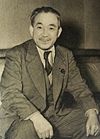 |
Suzuki Mosaburō (1893–1970) |
Rep for Tokyo 3rd |
18 January 1951 | 12 October 1955 | — | Yoshida 1948–54 | |
| Hatoyama I. 1954–56 | ||||||||
| Chair of the Social Democratic Party of Japan, Unified (1955-1996) | ||||||||
| 2 |  |
Suzuki Mosaburō (1893–1970) |
Rep for Tokyo 3rd |
12 October 1955 | 23 March 1960 | — | Hatoyama I. 1954–56 | |
| Ishibashi 1956–57 | ||||||||
| Kishi 1957–60 | ||||||||
| 3 |  |
Inejiro Asanuma (1898–1960) |
Rep for Tokyo 1st |
23 March 1960 | 12 October 1960 (assassinated) |
show 1960 |
||
| Ikeda 1960–64 | ||||||||
| — | 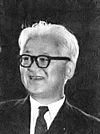 |
Saburō Eda (1907–1977) (acting) |
Cou for Okayama at-large |
12 October 1960 | 6 March 1961 | — | ||
| 4 |  |
Jōtarō Kawakami (1889–1965) |
Rep for Hyogo 1st |
6 March 1961 | 6 May 1965 | — | ||
| Satō 1964–72 | ||||||||
| 5 | 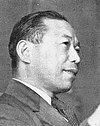 |
Kouzou Sasaki (1900–1985) |
Rep for Miyagi 1st |
6 May 1965 | 19 August 1967 | show January 1966 show December 1966 |
||
| 6 | 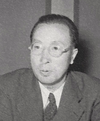 |
Seiichi Katsumata (1908–1989) |
Rep for Shizuoka 2nd |
19 August 1967 | 4 October 1968 | — | ||
| 7 | Tomomi Narita (1912–1979) |
Rep for Kagawa 1st |
30 November 1968 | 26 September 1977 | show 1970 |
|||
| Tanaka K. 1972–74 | ||||||||
| Miki 1974–76 | ||||||||
| Fukuda T. 1976–78 | ||||||||
| 8 |  |
Ichio Asukata (1915–1990) |
Rep for Tokyo 1st |
13 December 1977 | 7 September 1983 | show 1981 |
||
| Ōhira 1978–80 | ||||||||
| Ito 1980 (Acting) | ||||||||
| Suzuki Z. 1980–82 | ||||||||
| Nakasone 1982–87 | ||||||||
| 9 |  |
Masashi Ishibashi (1924–2019) |
Rep for Nagasaki 2nd |
7 September 1983 | 8 September 1986 | — | ||
| 10 | 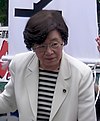 |
Takako Doi (1928–2014) |
Rep for Hyogo 2nd |
9 September 1986 | 31 July 1991 | show 1986 |
||
| Takeshita 1987–89 | ||||||||
| Uno 1989 | ||||||||
| Kaifu 1989–91 | ||||||||
| 11 | Makoto Tanabe (1922–2015) |
Rep for Gunma 1st |
31 July 1991 | 19 January 1993 | show 1991 |
|||
| Miyazawa 1991–93 | ||||||||
| 12 | Sadao Yamahana (1936–1999) |
Rep for Tokyo 11th |
19 January 1993 | 25 September 1993 | — | |||
| Hosokawa 1993–94 (coalition) | ||||||||
| 13 |  |
Tomiichi Murayama (b. 1924) |
Rep for Ōita 1st |
25 September 1993 | 19 January 1996 | show 1993 show 1996 |
||
| Hata 1994 | ||||||||
| himself 1994–96 | ||||||||
| Hashimoto 1996–98 (coalition, confidence and supply) | ||||||||
| Successor party: Social Democratic Party (centre-left to left-wing) | ||||||||
Election results[]
General election results[]
| Election | Leader | No. of seats won |
No. of constituency votes |
% of constituency votes |
No. of PR block votes |
% of PR block votes |
Government | |
|---|---|---|---|---|---|---|---|---|
| Japan Socialist Party era | ||||||||
| 1946 | Tetsu Katayama | 96 / 466
|
10,069,907 | 18.2 | Opposition | |||
| 1947 | Tetsu Katayama | 144 / 466
|
7,203,050 | 26.3 | Coalition | |||
| 1949 | Tetsu Katayama | 48 / 466
|
4,129,794 | 13.8 | Opposition | |||
| 1952 | Jōtarō Kawakami Mosaburō Suzuki |
116 / 466
|
8,001,745 | 22.6 | Opposition | |||
| 1953 | Jōtarō Kawakami Mosaburō Suzuki |
138 / 466
|
9,194,548 | 26.6 | Opposition | |||
| 1955 | Jōtarō Kawakami Mosaburō Suzuki |
156 / 466
|
10,812,906 | 29.2 | Opposition | |||
| 1958 | Mosaburō Suzuki | 167 / 467
|
13,155,715 | 33.1 | Opposition | |||
| 1960 | Jōtarō Kawakami | 144 / 467
|
10,839,130 | 27.4 | Opposition | |||
| 1963 | Jōtarō Kawakami | 144 / 467
|
11,906,766 | 29.0 | Opposition | |||
| 1967 | Kōzō Sasaki | 140 / 486
|
12,826,104 | 27.9 | Opposition | |||
| 1969 | Tomomi Narita | 90 / 486
|
10,074,101 | 21.4 | Opposition | |||
| 1972 | Tomomi Narita | 118 / 491
|
11,478,142 | 21.9 | Opposition | |||
| 1976 | Tomomi Narita | 123 / 511
|
11,713,009 | 20.7 | Opposition | |||
| 1979 | Ichio Asukata | 107 / 511
|
10,643,450 | 19.7 | Opposition | |||
| 1980 | Ichio Asukata | 107 / 511
|
11,400,747 | 19.3 | Opposition | |||
| 1983 | Masashi Ishibashi | 112 / 511
|
11,065,082 | 19.5 | Opposition | |||
| 1986 | Masashi Ishibashi | 85 / 512
|
10,412,584 | 17.2 | Opposition | |||
| 1990 | Takako Doi | 136 / 512
|
16,025,473 | 24.4 | Opposition | |||
| 1993 | Sadao Yamahana | 70 / 511
|
9,687,588 | 15.4 | Eight-party coalition (1993–1994) | |||
| LDP–JSP–NPS coalition (1994–1996) | ||||||||
Councillors election results[]
| Election | Leader | No. of seats total |
No. of seats won |
No. of National votes |
% of National vote |
No. of Prefectural votes |
% of Prefectural vote | |
|---|---|---|---|---|---|---|---|---|
| Japanese Socialist Party era | ||||||||
| 1947 | Tetsu Katayama | 47 / 250
|
3,479,814 | 16.4% | 4,901,341 | 23.0% | ||
| 1950 | Tetsu Katayama | 61 / 250
|
36 / 125
|
4,854,629 | 17.3% | 7,316,808 | 25.2% | |
| 1953 | Mosaburō Suzuki | 66 / 250
|
28 / 125
|
5,559,875 | 20.7% | 6,870,640 | 24.5% | |
| 1956 | Mosaburō Suzuki | 80 / 250
|
49 / 127
|
8,549,940 | 29.9% | 11,156,060 | 37.6% | |
| 1959 | Mosaburō Suzuki | 85 / 250
|
38 / 127
|
7,794,754 | 26.5% | 10,265,394 | 34.1% | |
| 1962 | Jōtarō Kawakami | 66 / 250
|
37 / 127
|
8,666,910 | 24.2% | 11,917,675 | 32.8% | |
| 1965 | Kōzō Sasaki | 73 / 251
|
36 / 127
|
8,729,655 | 23.4% | 12,346,650 | 32.8% | |
| 1968 | Tomomi Narita | 65 / 250
|
28 / 126
|
8,542,199 | 19.8% | 12,617,680 | 29.2% | |
| 1971 | Tomomi Narita | 66 / 249
|
39 / 125
|
8,494,264 | 21.3% | 12,597,644 | 31.2% | |
| 1974 | Tomomi Narita | 62 / 250
|
28 / 130
|
7,990,457 | 15.2% | 13,907,865 | 26.0% | |
| 1977 | Ichio Asukata | 56 / 249
|
27 / 126
|
8,805,617 | 17.3% | 13,403,216 | ||
| 1980 | Ichio Asukata | 47 / 250
|
22 / 126
|
7,341,828 | 13.1% | 12,715,880 | ||
| 1983 | Ichio Asukata | 44 / 252
|
22 / 126
|
7,590,331 | 16.3% | 11,217,515 | ||
| 1986 | Takako Doi | 41 / 252
|
20 / 126
|
9,869,088 | 12,464,579 | |||
| 1989 | Takako Doi | 68 / 252
|
45 / 126
|
19,688,252 | 35.1% | 15,009,451 | 26.4% | |
| 1992 | Takako Doi | 71 / 252
|
22 / 126
|
7,981,726 | 17.8% | 7,147,140 | 15.8% | |
| 1995 | Tomiichi Murayama | 37 / 252
|
16 / 126
|
6,882,919 | 16.9% | 4,926,003 | 11.9% | |
See also[]
References[]
Citations[]
- ^ Jump up to: a b c d e f g h i ブリタニカ国際大百科事典 小項目事典の解説 [The Encyclopædia Britannica: Micropædia 's explanation]. kotobank.jp (in Japanese). The Asahi Shimbun Company. Retrieved 22 November 2020.
- ^ Jump up to: a b c d e f Taguchi, Fukuji. 日本大百科全書(ニッポニカ)の解説 [The Nihon Dai Hyakka Zensho: Nipponica 's explanation]. kotobank.jp (in Japanese). The Asahi Shimbun Company. Retrieved 19 November 2020.
- ^ 社会新報とは § ブリタニカ国際大百科事典 小項目事典の解説 [What is Shakai Shimpō? § The Encyclopædia Britannica: Micropædia 's explanation]. kotobank.jp (in Japanese). The Asahi Shimbun Company. Retrieved 22 November 2020.
- ^ "Social Democratic Party of Japan | political party, Japan". Encyclopædia Britannica Online. Encyclopædia Britannica, Inc. Retrieved 22 November 2020.
- ^ Docherty, James C.; Lamb, Peter (2006). Historical Dictionary of Socialism. Historical Dictionaries of Religions, Philosophies, and Movements Series (2nd ed.). The Scarecrow Press. p. 186. ISBN 978-0-8108-5560-1. Retrieved 22 November 2020.
- ^ Ken Saito (2019). 圖說日本大事記:1945-2017,改變與形塑現代日本的百大事件. 麥浩斯. p. 50. ISBN 978-986-408-463-0.
- ^ Lee, Yong Wook. "The Origin of One Party Domination: America's Reverse Course and the Emergence of the Liberal Democratic Party in Japan". The Journal of East Asian Affairs. 18 (2): 388. Retrieved 26 January 2021.
- ^ Hoover, William D. (2011). Historical Dictionary of Postwar Japan. Plymouth, UK: Scarecrow Press. p. 33. ISBN 978 0 8108 5460 4.
- ^ Takemae, Eiji (January 2003). Allied Occupation of Japan. ISBN 9780826415219. Archived from the original on 3 May 2018. Retrieved 12 July 2015.
- ^ "Occupation and Reconstruction of Japan, 1945–52". Retrieved 26 January 2021.
By late 1947 and early 1948, the emergence of an economic crisis in Japan alongside concerns about the spread of communism sparked a reconsideration of occupation policies. This period is sometimes called the 'reverse course.'
- ^ Schonberger, Howard B. (1989). Aftermath of War: Americans and the Remaking of Japan, 1945-1952. Kent, Ohio: The Kent State University Press. pp. 64–72. ISBN 0 87338 382 6.
- ^ Dower, John W.; Hirata, Tetsuo. "Japan's Red Purge: Lessons from a Saga of Suppression of Free Speech and Thought". The Asia-Pacific Journal. 5 (7): 3. Retrieved 26 January 2021.
- ^ Socialist parties in postwar Japan, by Allan B. Cole, George O. Totten [and] Cecil H. Uyehara, New Haven : Yale University Press, 1966.
- ^ Kapur 2018, pp. 109-112.
- ^ Kapur 2018, pp. 109-113.
- ^ Jump up to: a b c d Kapur 2018, p. 127.
- ^ Kapur 2018, pp. 121-126.
- ^ Kapur 2018, p. 114.
- ^ Kapur 2018, pp. 116-121.
- ^ Kapur 2018, pp. 118.
- ^ Jump up to: a b c Kapur 2018, pp. 124.
- ^ Jump up to: a b c d e Kapur 2018, p. 125.
- ^ Kapur 2018, pp. 125-126.
- ^ MacDougall, Terry (2001). "Towards Political Inclusiveness: The Changing Role of Local Government in Japan" (PDF). The World Bank Institute. p. 11. Archived from the original (PDF) on 2 December 2012. Retrieved 20 April 2012.
- ^ Hein, Carola; Pelletier, Philippe (2006). Cities, Autonomy, and Decentralization in Japan. p. 131. ISBN 9781134341504. Archived from the original on 27 November 2016. Retrieved 12 July 2015.
- ^ Muramatsu, Michio; Iqbal, Farrukh; Kume, Ikuo (2001). Local Government Development in Post-war Japan. p. 51. ISBN 9780199248285.
- ^ Gaunder, Alisa (25 February 2011). Routledge Handbook of Japanese Politics. ISBN 9781136818387. Archived from the original on 27 November 2016. Retrieved 12 July 2015.
- ^ "FEATURE: Seeds planted by 'progressive' governments still sprouting in Japan". Retrieved 12 July 2015.
- ^ "Controlled Decentralization: Local Governments and the Ministry of Home Affairs in Japan" (PDF). Archived (PDF) from the original on 12 July 2015. Retrieved 10 August 2013.
- ^ Tsuzuki, Chushichi (13 April 2000). The Pursuit of Power in Modern Japan 1825-1995. ISBN 9780191542459. Archived from the original on 3 May 2018. Retrieved 12 July 2015.
- ^ 福岡義登 (1985). "江田三郎先生を偲んで". In 日本社会党前議員会 (ed.). 日本社会党歴代委員長の思い出: 亡くなられた委員長をしのぶ. 日本社会党前議員会. p. 319.
- ^ 社会民主連合. 朝日新聞社Kotobank. Archived from the original on 26 February 2020. Retrieved 26 February 2020.
- ^ 江田三郎. 朝日新聞社Kotobank. Archived from the original on 26 February 2020. Retrieved 26 February 2020.
- ^ Ian Neary (12 October 2012). War, Revolution and Japan. Taylor & Francis. pp. 141–. ISBN 978-1-873410-08-0. Retrieved 29 January 2013.
- ^ 高山直人 (2019). 左翼大辞典. 明哲の舎. p. 7. GGKEY:9NSLG3F0CUC.
Bibliography[]
- Kapur, Nick (2018). Japan at the Crossroads: Conflict and Compromise after Anpo. Cambridge, MA: Harvard University Press. ISBN 978-0674984424.
- Political parties established in 1945
- Socialist parties in Japan
- Social democratic parties in Japan
- Progressivism in Japan
- Progressive parties
- Former member parties of the Socialist International
- Political parties disestablished in 1996
- 1945 establishments in Japan
- 1996 disestablishments in Japan